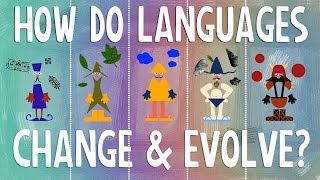(单词翻译:单击)
In the biblical story of the Tower of Babel,
在圣经故事巴别塔中,
all of humanity once spoke a single language until they suddenly split into many groups unable to understand each other.
所有人类都讲同一种语言,直到他们突然分裂成多个相互之间都听不懂的族群。
We don't really know if such an original language ever existed,
我们不知道是否曾经存在过这么一种初始语言,
but we do know that the thousands of languages existing today can be traced back to a much smaller number.
但我们知道如今的成千上万种语言可以追溯到有限的几种。
So how did we end up with so many?
那么我们是如何最终形成这么多语言的呢?
In the early days of human migration, the world was much less populated.
在早期人类迁徙的时候,地球上人烟稀少。
Groups of people that shared a single language and culture often split into smaller tribes,
拥有同一种语言文化的族群通常分裂为更小的部落,
going separate ways in search of fresh game and fertile land.
分头各自寻找野味和肥沃的土地。
As they migrated and settled in new places,
当他们迁移定居在新的地方后,
they became isolated from one another and developed in different ways.
相互之间变得疏远并以各自不同的方式发展。
Centuries of living in different conditions, eating different food and encountering different neighbors
几个世纪的不同生活条件,不同食物,不同邻居,
turned similar dialects with varied pronunciation and vocabulary into radically different languages,
使原本相似而只是发音和词汇有所不同的方言变成了完全不同的语言,
continuing to divide as populations grew and spread out further.
并随着人口的增长和迁移不断分化。
Like genealogists, modern linguists try to map this process
系谱学家、现代语言学家等试图重现这个过程,
by tracing multiple languages back as far as they can to their common ancestor, or protolanguage.
他们尽力追溯不同语言的共同的起源,也称为原始母语。
A group of all languages related in this way is called a language family, which can contain many branches and sub-families.
以同一原始母语演化而来的不同语言称为一个语系,它可能包括很多分支和子系。
So how do we determine whether languages are related in the first place?
那么我们如何确定不同语言在开始的时候是有关联的呢?
Similar sounding words don't tell us much.
相似的发音并不能说明什么。
They could be false cognates or just directly borrowed terms rather than derived from a common root.
它们可能是被误解的同源词或者只是外来语,而不是源于同根。
Grammar and syntax are a more reliable guide, as well as basic vocabulary,
语法和句法有更可靠的指导意义,基本词汇也是,
such as pronouns, numbers or kinship terms, that's less likely to be borrowed.
像代词、数字或亲属称谓,这些都不太可能是外来语。

By systematically comparing these features and looking for regular patterns of sound changes and correspondences between languages,
通过系统地比较这些特征,查找读音变化的常见形式和不同语言的对应关系,
linguists can determine relationships, trace specific steps in their evolution
语言学家能们够确定它们之间的关系,追溯它们发展演变的详细过程,
and even reconstruct earlier languages with no written records.
甚至重建没有文字记录的早期语言。
Linguistics can even reveal other important historical clues,
语言学家们甚至可以发现其他重要的历史线索,
such as determining the geographic origins and lifestyles of ancient peoples based on which of their words were native, and which were borrowed.
比如确定地理起源和古代人的生活方式,这是基于他们的语言哪些是母语,哪些是外来语。
There are two main problems linguists face when constructing these language family trees.
语言学家们在重建这些语言系谱时主要面临两大问题。
One is that there is no clear way of deciding where the branches at the bottom should end,
一个是没有清晰定义系谱树的枝干末端在哪里,
that is, which dialects should be considered separate languages or vice versa.
也就是说,哪种方言应该被认为是不同语言或只是方言。
Chinese is classified as a single language, but its dialects vary to the point of being mutually unintelligible,
汉语被归类为一门语言,但它的不同方言之间差别大到完全听不懂,
while speakers of Spanish and Portuguese can often understand each other.
而讲西班牙语和葡萄牙语的人们通常可以听懂对方。
Languages actually spoken by living people do not exist in neatly divided categories,
正在被人类使用的语言不存在严格的种类划分,
but tend to transition gradually, crossing borders and classifications.
而是逐渐过渡,跨越界限和分类。
Often the difference between languages and dialects
通常语言和方言的不同之处在于
is a matter of changing political and national considerations, rather than any linguistic features.
多变的政治和国家格局,而不是语言学特征。
This is why the answer to, 'How many languages are there?' can be anywhere between 3,000 and 8,000, depending on who's counting.
这就是为什么“这个世界上究竟有多少种语言”的答案可能是3000-8000之间某个数,它取决于谁来数。
The other problem is that the farther we move back in time towards the top of the tree,
另一个问题是我们沿着系谱树回溯越接近树的顶端,
the less evidence we have about the languages there.
关于语言的证据就越少。
The current division of major language families represents the limit at which relationships can be established with reasonable certainty,
现在对主要语系的划分,在合理的可能性内,不同语言之间的关系仅限于这几种,
meaning that languages of different families are presumed not to be related on any level. But this may change.
就意味着不同语系的语言在任一层面上都没有交集。但这种情况可能会变。
While many proposals for higher level relationships -- or super families -- are speculative,
很多人推测存在更高层面的关系,也就是超级语系,
some have been widely accepted and others are being considered,
一些说法已经被广泛认同,另一些还有争议,
especially for native languages with small speaker populations that have not been extensively studied.
特别是对只有较少人使用的语言还没有全面研究。
We may never be able to determine how language came about,
我们也许永远不会知道语言从何而来,
or whether all human languages did in fact have a common ancestor scattered through the babel of migration.
也不知道人类语言是否真有共同的原始母语,并通过移民们散落于各处。
But the next time you hear a foreign language, pay attention.
不过当你下一次听到一门外语的时候,留意一下。
It may not be as foreign as you think.
它也许并没有你想象的那么不同。


